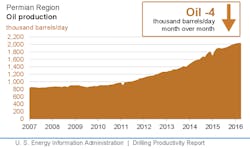EIA projects monthly oil production decline for Permian
A year after US shale oil production began its decline, output form the Permian basin is finally projected to follow suit.
Crude oil production in April from the seven major US shale regions is expected to fall 106,000 b/d to 4.87 million b/d, according to the US Energy Information Administration’s latest Drilling Productivity Report (DPR). That includes a 4,000-b/d drop in the Permian to 2.04 million b/d.
The DPR focuses on the Bakken, Eagle Ford, Haynesville, Marcellus, Niobrara, Permian, and Utica, which altogether accounted for 95% of US crude production increases and all US natural gas production increases during 2011-13.
The Eagle Ford is expected to contribute its usual largest share of declines, shedding 58,000 b/d to 1.18 million b/d. The Bakken is anticipated to fall 28,000 b/d to 1.08 million b/d, while the Niobrara is expected to drop 15,000 b/d to 408,000 b/d.
New-well oil production/rig across the seven plays in April is expected to increase by a rig-weighted average of 12 b/d to 528 b/d. The Niobrara is projected to lead the way with a 25-b/d jump to 803 b/d, followed by the Utica with a 14-b/d rise to 324 b/d, Eagle Ford with a 10-b/d increase to 830 b/d, Bakken with a 6-b/d gain to 752 b/d, and Permian with a 6-b/d rise to 444 b/d.
Data published last week by the EIA showed overall US crude production in December averaged 9.26 million b/d, down from 9.31 million b/d in November and 9.43 million b/d in December 2014 (OGJ Online, Mar. 1, 2016).
US shale gas production in April from the seven regions, meanwhile, is forecast in the DPR to fall 450 MMcfd to 46.31 bcfd. The Eagle Ford also is projected to take the largest hit, losing 182 MMcfd to 6.34 bcfd, followed by a 108-MMcfd drop in the Marcellus to 17.32 bcfd. The only increase is expected in the Utica, up 22 MMcfd to 3.65 bcfd.


